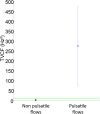Discriminative imaging of maternal and fetal blood flow within the placenta using ultrafast ultrasound
- PMID: 26373902
- PMCID: PMC4570988
- DOI: 10.1038/srep13394
Discriminative imaging of maternal and fetal blood flow within the placenta using ultrafast ultrasound
Abstract
Being able to map accurately placental blood flow in clinics could have major implications in the diagnosis and follow-up of pregnancy complications such as intrauterine growth restriction (IUGR). Moreover, the impact of such an imaging modality for a better diagnosis of placental dysfunction would require to solve the unsolved problem of discriminating the strongly intricated maternal and fetal vascular networks. However, no current imaging modality allows both to achieve sufficient sensitivity and selectivity to tell these entangled flows apart. Although ultrasound imaging would be the clinical modality of choice for such a problem, conventional Doppler echography both lacks of sensibility to detect and map the placenta microvascularization and a concept to discriminate both entangled flows. In this work, we propose to use an ultrafast Doppler imaging approach both to map with an enhanced sensitivity the small vessels of the placenta (~100 μm) and to assess the variation of the Doppler frequency simultaneously in all pixels of the image within a cardiac cycle. This approach is evaluated in vivo in the placenta of pregnant rabbits: By studying the local flow pulsatility pixel per pixel, it becomes possible to separate maternal and fetal blood in 2D from their pulsatile behavior. Significance Statement: The in vivo ability to image and discriminate maternal and fetal blood flow within the placenta is an unsolved problem which could improve the diagnosis of pregnancy complications such as intrauterine growth restriction or preeclampsia. To date, no imaging modality has both sufficient sensitivity and selectivity to discriminate these intimately entangled flows. We demonstrate that Ultrafast Doppler ultrasound method with a frame rate 100x faster than conventional imaging solves this issue. It permits the mapping of small vessels of the placenta (~100 μm) in 2D with an enhanced sensitivity. By assessing pixel-per-pixel pulsatility within single cardiac cycles, it achieves maternal and fetal blood flow discrimination.
Figures





Similar articles
-
[Doppler study of the fetal and uteroplacental blood flows in IUGR].Akush Ginekol (Sofiia). 1990;29(3):1-8. Akush Ginekol (Sofiia). 1990. PMID: 2252137 Bulgarian.
-
Computer analysis of three-dimensional power angiography images of foetal cerebral, lung and placental circulation in normal and high-risk pregnancy.Ultrasound Med Biol. 2005 Mar;31(3):321-7. doi: 10.1016/j.ultrasmedbio.2004.12.008. Ultrasound Med Biol. 2005. PMID: 15749554
-
Two-dimensional and three-dimensional Doppler assessment of fetal growth restriction with different severity and onset.Prenat Diagn. 2012 Dec;32(12):1174-80. doi: 10.1002/pd.3980. Epub 2012 Oct 17. Prenat Diagn. 2012. PMID: 23074059
-
Doppler vascular changes in intrauterine growth restriction.Semin Perinatol. 2008 Jun;32(3):182-9. doi: 10.1053/j.semperi.2008.02.011. Semin Perinatol. 2008. PMID: 18482619 Review.
-
Three-dimensional ultrasound evaluation of the placenta.Placenta. 2011 Feb;32(2):105-15. doi: 10.1016/j.placenta.2010.11.001. Epub 2010 Nov 27. Placenta. 2011. PMID: 21115197 Review.
Cited by
-
Intrauterine xenotransplantation of human Wharton jelly-derived mesenchymal stem cells into the liver of rabbit fetuses: A preliminary study for in vivo expression of the human liver genes.Iran J Basic Med Sci. 2018 Jan;21(1):89-96. doi: 10.22038/IJBMS.2017.24501.6098. Iran J Basic Med Sci. 2018. PMID: 29372042 Free PMC article.
-
Umbilical Vein Pulse Wave Spectral Analysis: A Possible Method for Placental Assessment Through Evaluation of Maternal and Fetal Flow Components.J Ultrasound Med. 2022 Oct;41(10):2445-2457. doi: 10.1002/jum.15927. Epub 2021 Dec 21. J Ultrasound Med. 2022. PMID: 34935157 Free PMC article.
-
Visualization of Small-Diameter Vessels by Reduction of Incoherent Reverberation With Coherent Flow Power Doppler.IEEE Trans Ultrason Ferroelectr Freq Control. 2016 Nov;63(11):1878-1889. doi: 10.1109/TUFFC.2016.2616112. IEEE Trans Ultrason Ferroelectr Freq Control. 2016. PMID: 27824565 Free PMC article.
-
Stereological Evaluation of Rabbit Fetus Liver after Xenotransplantation of Human Wharton's Jelly-Derived Mesenchymal Stromal Cells.Int J Organ Transplant Med. 2022;13(1):15-24. Int J Organ Transplant Med. 2022. PMID: 37383424 Free PMC article.
-
Placental MRI Predicts Fetal Oxygenation and Growth Rates in Sheep and Human Pregnancy.Adv Sci (Weinh). 2022 Oct;9(30):e2203738. doi: 10.1002/advs.202203738. Epub 2022 Aug 28. Adv Sci (Weinh). 2022. PMID: 36031385 Free PMC article.
References
-
- Redman C. W. & Sargent I. L. Latest Advances in Understanding Preeclampsia. Science 308, 1592–1594 (2005). - PubMed
-
- Jones H. N., Powell T. L. & Jansson T. Regulation of Placental Nutrient Transport—A Review. Placenta 28, 763–774 (2007). - PubMed
-
- Hata T., Tanaka H., Noguchi J. & Hata K. Three-dimensional ultrasound evaluation of the placenta. Placenta 32, 105–115 (2011). - PubMed
-
- Dar P. et al. First-trimester 3-dimensional power Doppler of the uteroplacental circulation space: a potential screening method for preeclampsia. Am. J. Obstet. Gynecol. 203, 238.e1–238.e7 (2010). - PubMed
Publication types
MeSH terms
LinkOut - more resources
Full Text Sources
Other Literature Sources

